Surface Velocity and Dynamics of the Southern Patagonian Icefield Using Feature and Speckle Tracking Methods on Sentinel-1 SAR Images During 2019–2020
Highlights
- The velocity of Southern Patagonian Icefield (SPI) glaciers was examined using feature and speckle tracking methods based on Sentinel-1 SAR images, reveal an unstable and fast changing state of the SPI.
- Observations support that calving has a massive effect on SPI glacier velocity. On the other hand, topographic parameters have a weaker effect on ice velocity.
- SPI glaciers have a significant role in water supply, and glacier-related changes also represent a natural hazard. Accelerating changes mean that in the medium term, there will be problems with water supply, and risks will also increase.
- Andean glaciers, including the SPI, could lose more than 36% of their current mass by 2100. Our study provides an opportunity to better understand the changes and the future of the SPI.
Abstract
1. Introduction
2. Background
2.1. Study Area
2.1.1. Ice Loss of the SPI
2.1.2. Ice Velocities on the SPI
| Publication | Examined Glacier(s) | Satellite and Sensor | Method | Date | Time Intervals |
|---|---|---|---|---|---|
| Bown et al., 2019 [40] | Jorge Montt | NASA ASTER and Landsat TM, ETM+ and OLI; ESA Sentinel-2 | Feature Tracking | 1 May 2013–30 April 2017 | 7–384 days |
| Ciappa et al., 2010 [48] | Moreno (only 5 km away from the terminus) | COSMO SkyMed X-band SAR | Feature Tracking | 2 February–27 December 2009 (except June) | 8–16 days |
| Euillades et al., 2016 [49] | Viedma | COSMO SkyMed STRIPMAP | Speckle Tracking | 12 April 2012–10 January 2013 | 16 days |
| Floricioiu et al., 2008 and 2009 [42,50] | Ameghino Moreno Upsala | TerraSAR-X | Feature Tracking | 27 December 2007–31 January 2008 January 2008–May 2009 | 11 days |
| Lo Vecchio et al., 2018 [51] | Viedma | NASA Landsat 8 | Feature Tracking | 13 October 2015–3 March 2016 | 16–32 days |
| Moragues et al., 2018 [52] | Upsala | NASA ASTER | Feature Tracking | 25 January 2013–4 February 2014 | 16–48 days |
| Mouginot and Rignot (2015) [13] | SPI (87% of the Icefield) | NASA SIR-C and Landsat; ESA ERS-1 and ERS-2; CSA RADARSAT-1; ALOS PALSAR | Speckle Tracking and Feature Tracking (only for Landsat) | 1984–2014 | 1–35 days |
| Muto and Furuya (2013) [43] | Jorge Montt Moreno Occidental O’Higgins Pío XI Upsala Viedma | Envisat ASAR | Speckle Tracking | 2003–2011 | 35 days |
| Rivera et al., 2012 [9] | Jorge Montt | Terrestrial cameras (CANON EOS Rebel xti 400D 10.1; NASA ASTER | Feature Tracking | With cameras: 8 February 2010–15 January 2011; With satellite images: 16–25 February 2010 | 4 photos/day; 9 days (with satellite images) |
| Riveros et al., 2013 [53] | Viedma | COSMO SkyMed X-band SAR | Speckle Tracking | 28 April–18 June 2012 | 1–16 days |
| Rott et al., 1998 [54] | Moreno | NASA SIR-C | Speckle Tracking | 7–10 October 1994 | 1–2 days |
| Sakakibara and Sugiyama (2014) [44] | SPI (28 glaciers, 44% of the Icefield) | NASA Landsat 4 and TM and Landsat 7 ETM+ | Feature Tracking | 1984–2011 | 16–192 days |
| Sakakibara et al., 2013 [55] | Upsala (only in 4 squares) | Landsat 7 ETM+ | Feature Tracking | 7 May 2001–3 May 2011 | 97–272 days |
| Skvarca et al., 2003 [56] | Upsala | Landsat 7 ETM+ | Feature Tracking | 27 October 2000–14 October 2001 | 32–353 days |
2.2. The Effect of Calving on Ice Velocity
2.3. Future Use of Meltwater and Related Natural Hazards in the Patagonian Icefield
3. Materials and Methods
3.1. Feature and Speckle Tracking
3.2. Sample Velocity Maps
3.3. SRTM Digital Terrain Model Analysis and Ice Thickness Data
3.4. Heatmaps
4. Results
4.1. Coverage of Velocity Measurement
4.2. Topographic Parameters
4.3. Surface Velocity Values of Glaciers
- Increasing velocity profile: Starting from the terminus, there is an increase in velocity.
- (a)
- Constant or slightly increasing velocity zone at the lower part of the glacier and a higher rate of increase at the upper part of the glacier, with a small decrease in velocity between these parts.Glaciers: Agassiz Bolados, Ameghino, Balmaceda, HPS10, Pascua, SPI116, SPI198, SPI84.
- (b)
- Starting from the terminus, a continuous increase in velocity can be observed towards the accumulation area. The number of sample areas is low in this subtype.Glaciers: Snowy, SPI106, SPI205, SPI81, SPI98.
- Decreasing velocity profile: Starting from the terminus, there is a more or less continuous decrease in velocity towards the accumulation area, with short segments where the velocity increases going upwards.Glaciers: Asia, O’Nelli, SPI104, Viedma.
- Single-peak velocity profile: There is a single peak of velocity values below which and above which the velocity is smaller. This velocity peak can be either at the lower part or at the middle part of the glacier.Glaciers: Bravo, Calvo, Europa, HPS12, HPS15, HPS31, O’Higgins, Oriental, Penguin, Pingo, SPI107, SPI111, SPI115, SPI119, SPI121, SPI127, SPI135, SPI15, SPI200, SPI201, SPI202, SPI203, SPI44, SPI5.
- Multiple-peak velocity profile: There are several peaks in the velocity profile, i.e., the glacier has several segments of high velocity and several segments of low velocity.Glaciers: Amalia, Bernard, Chico, Greve, Grey, Guilardi, HPS13, HPS19, HPS29, HPS9, Jorge Montt, Lucia, Mayo, Moreno, Occidentalt, Ofhidro, Pío XI, Spegazzini, SPI131, SPI204, Tampanot, Tindall, Upsala.
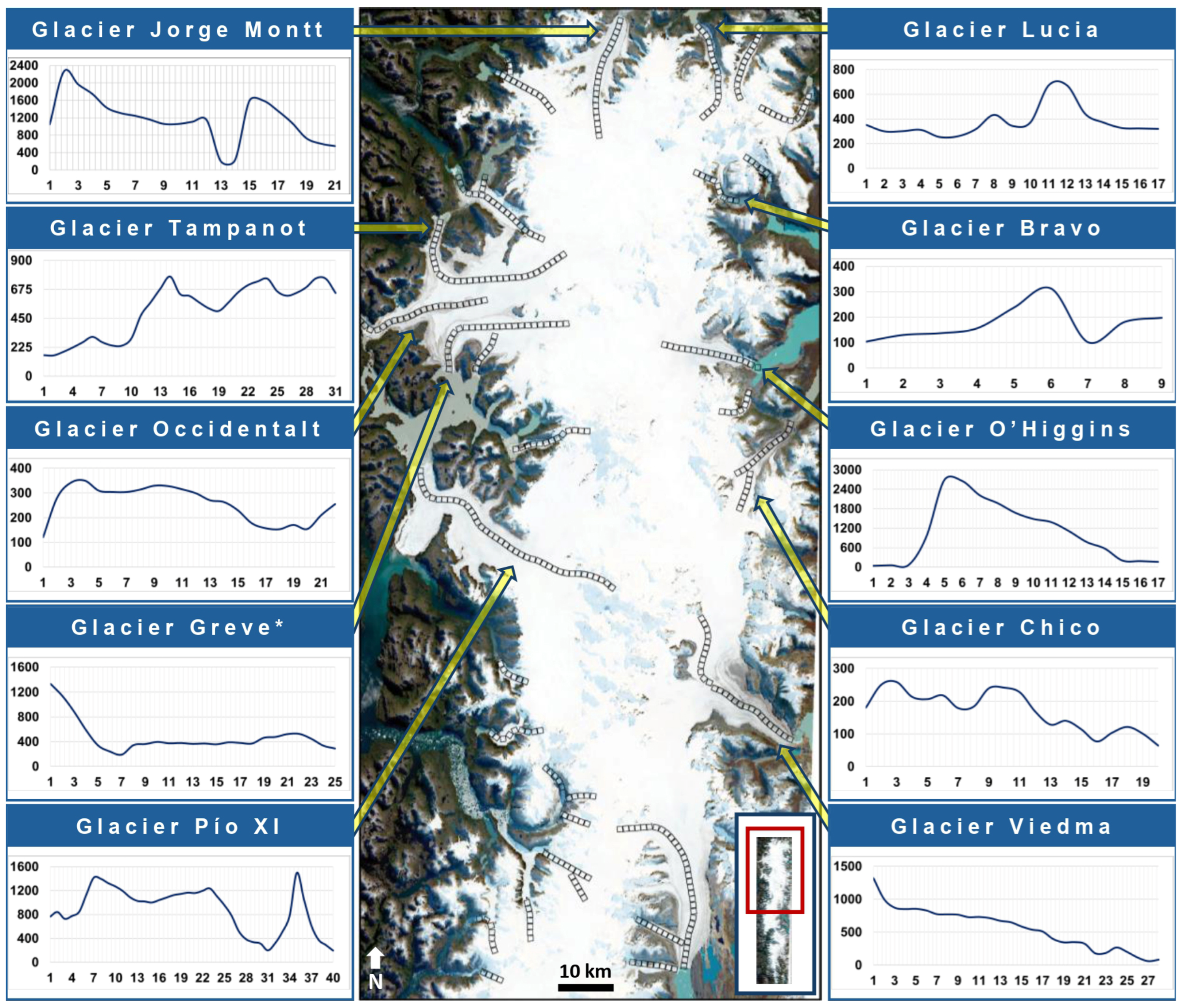
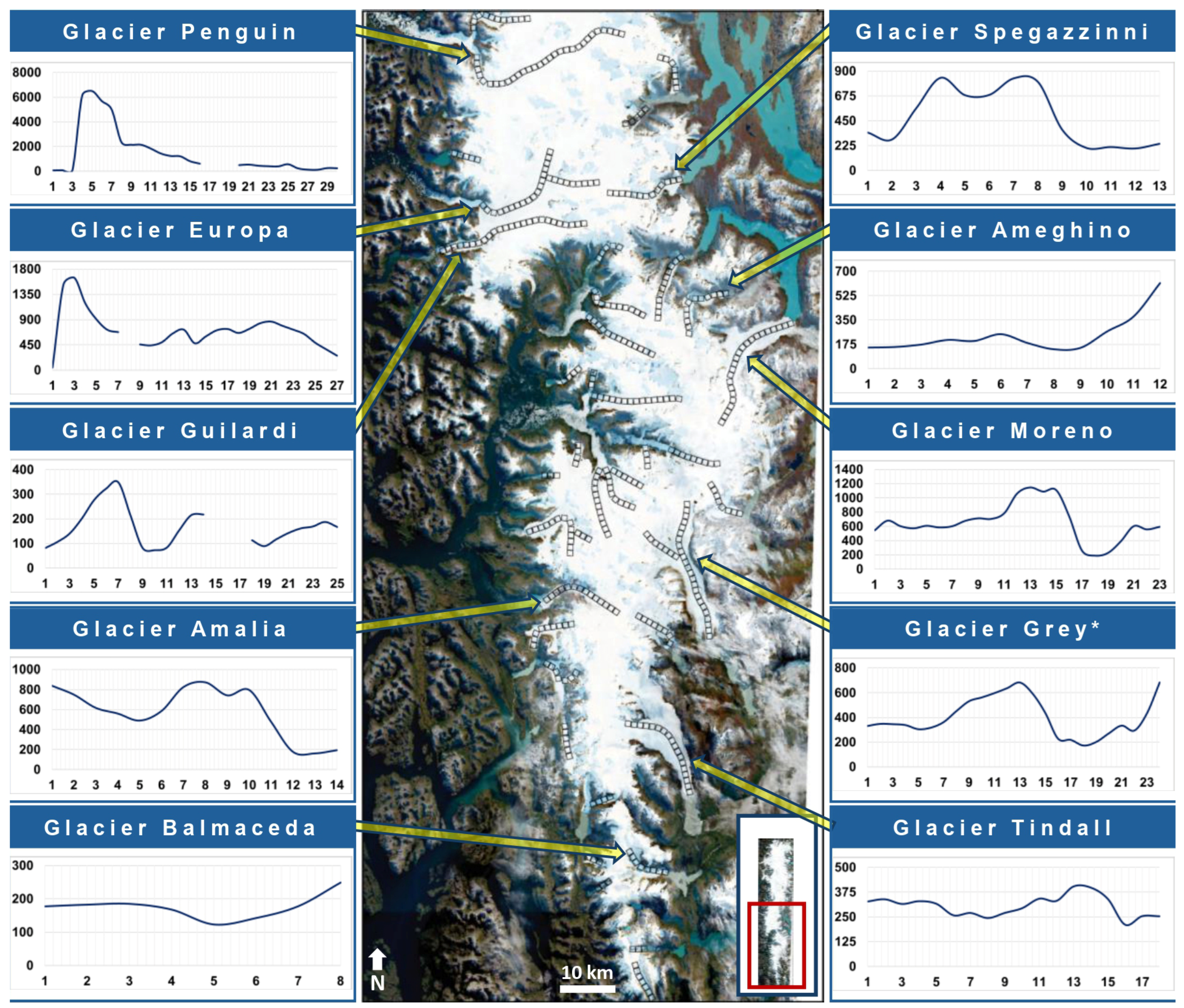
4.4. Interpretation of the Heatmaps
4.4.1. Fastest-Moving Areas (FMAs)
4.4.2. Seasonal Fluctuations
4.4.3. Pío XI Glacier Acceleration
4.4.4. Tidewater Glaciers with Continuous Rapid Movement
5. Discussion
5.1. The Variability of the Measured Velocity
5.2. Glacier-by-Glacier Discussion of Velocity Changes
5.2.1. Moreno Glacier
5.2.2. Upsala and O’Higgins Glaciers
5.2.3. Viedma Glacier
5.2.4. Ameghino Glacier
5.2.5. Jorge Montt Glacier
5.3. The Effect of Calving on Velocity
6. Conclusions
Supplementary Materials
Author Contributions
Funding
Data Availability Statement
Acknowledgments
Conflicts of Interest
Abbreviations
| SPI | Southern Patagonian Icefield |
| FMA | Fast-moving area |
References
- Aniya, M.; Shizukuishi, M.; Skvarca, P.; Casassa, G. Monitoring Recent Glacier Variations in the Southern Patagonia Icefield, Utilizing Remote Sensing Data. Int. Arch. Photogramm. Remote Sens. Spat. Inf. Sci. 1992, 29, 87–94. [Google Scholar]
- Barry, R.G. The Status of Research on Glaciers and Global Glacier Recession: A Review. Prog. Phys. Geogr. Earth Environ. 2006, 30, 285–306. [Google Scholar] [CrossRef]
- Vincent, C.; Soruco, A.; Six, D.; Meur, E.L. Glacier Thickening and Decay Analysis from 50 Years of Glaciological Observations Performed on Glacier d’Argentière, Mont Blanc Area, France. Ann. Glaciol. 2009, 50, 73–79. [Google Scholar] [CrossRef]
- Immerzeel, W.W.; Lutz, A.F.; Andrade, M.; Bahl, A.; Biemans, H.; Bolch, T.; Hyde, S.; Brumby, S.; Davies, B.J.; Elmore, A.C.; et al. Importance and Vulnerability of the World’s Water Towers. Nature 2020, 577, 364–369. [Google Scholar] [CrossRef] [PubMed]
- Mark, B.G.; Baraer, M.; Fernandez, A.; Immerzeel, W.; Moore, R.D.; Weingartner, R. Glaciers as Water Resources. In The High-Mountain Cryosphere: Environmental Changes and Human Risks; Kääb, A., Huggel, C., Clague, J.J., Carey, M., Eds.; Cambridge University Press: Cambridge, UK, 2015; pp. 184–203. ISBN 978-1-107-06584-0. [Google Scholar]
- Viviroli, D.; Dürr, H.H.; Messerli, B.; Meybeck, M.; Weingartner, R. Mountains of the World, Water Towers for Humanity: Typology, Mapping, and Global Significance. Water Resour. Res. 2007, 43. [Google Scholar] [CrossRef]
- Kinnard, C.; MacDonell, S.; Petlicki, M.; Martinez, C.M.; Abermann, J.; Urrutia, R. Mass Balance and Meteorological Conditions at Universidad Glacier, Central Chile. In Andean Hydrology; CRC Press: Boca Raton, FL, USA, 2018; pp. 102–126. [Google Scholar]
- Jó, V.; Van Wyk de Vries, M.; Ignéczi, Á.; Mari, L.; Nagy, B. Glacier Slowdown and Rapid Ice Loss in the Tinguiririca and Cachapoal Basin, Central Andes of Chile. Glob. Planet. Change 2023, 231, 104287. [Google Scholar] [CrossRef]
- Rivera, A.; Koppes, M.; Bravo, C.; Aravena, J.C. Little Ice Age Advance and Retreat of Glaciar Jorge Montt, Chilean Patagonia. Clim. Past 2012, 8, 403–414. [Google Scholar] [CrossRef]
- Watson, C.S.; Quincey, D. Glacier Movement. In Geomorphological Techniques (Online Edition); Clarke, L.E., Nield, J.M., Eds.; British Society for Geomorphology: London, UK, 2015. [Google Scholar]
- Cuffey, K.M.; Paterson, W.S.B. The Physics of Glaciers, 4th, ed.; Butterwoth-Heinemann and Elsevier: Oxford, UK, 2010; ISBN 978-0-12-369461-4. [Google Scholar]
- Jiskoot, H. Dynamics of Glaciers. In Encyclopedia of Snow, Ice and Glaciers; Springer: Dordrecht, The Netherlands, 2011; pp. 245–256. ISBN 978-90-481-2642-2. [Google Scholar]
- Mouginot, J.; Rignot, E. Ice Motion of the Patagonian Icefields of South America: 1984–2014. Geophys. Res. Lett. 2015, 42, 1441–1449. [Google Scholar] [CrossRef]
- Joughin, I.; Abdalati, W.; Fahnestock, M. Large Fluctuations in Speed on Greenland’s Jakobshavn Isbræ Glacier. Nature 2004, 432, 608–610. [Google Scholar] [CrossRef]
- Schaefer, M.; Machguth, H.; Falvey, M.; Casassa, G.; Rignot, E. Quantifying Mass Balance Processes on the Southern Patagonia Icefield. Cryosphere 2015, 9, 25–35. [Google Scholar] [CrossRef]
- Frezzotti, M.; Capra, A.; Vittuari, L. Comparison between Glacier Ice Velocities Inferred from GPS and Sequential Satellite Images. Ann. Glaciol. 1998, 27, 54–60. [Google Scholar] [CrossRef]
- Ahn, Y.; Howat, I.M. Efficient Automated Glacier Surface Velocity Measurement From Repeat Images Using Multi-Image/Multichip and Null Exclusion Feature Tracking. IEEE Trans. Geosci. Remote Sens. 2011, 49, 2838–2846. [Google Scholar] [CrossRef]
- Rolstad, C.; Amlien, J.; Hagen, J.-O.; Lundén, B. Visible and Near-Infrared Digital Images for Determination of Ice Velocities and Surface Elevation during a Surge on Osbornebreen, a Tidewater Glacier in Svalbard. Ann. Glaciol. 1997, 24, 255–261. [Google Scholar] [CrossRef]
- Mohr, J.J.; Reeh, N.; Madsen, S.N. Three-Dimensional Glacial Flow and Surface Elevation Measured with Radar Interferometry. Nature 1998, 391, 273–276. [Google Scholar] [CrossRef]
- Csathó, B.M.; Bolzan, J.F.; van der Veen, C.J.; Schenk, A.F.; Lee, D. Surface Velocities of a Greenland Outlet Glacier from High-resolution Visible Satellite Imagery 1. Polar Geogr. 1999, 23, 71–82. [Google Scholar] [CrossRef]
- Bamber, J.L.; Vaughan, D.G.; Joughin, I. Widespread Complex Flow in the Interior of the Antarctic Ice Sheet. Science 2000, 287, 1248–1250. [Google Scholar] [CrossRef]
- Luckman, A.; Murray, T.; Jiskoot, H.; Pritchard, H.; Strozzi, T. ERS SAR Feature-Tracking Measurement of Outlet Glacier Velocities on a Regional Scale in East Greenland. Ann. Glaciol. 2003, 36, 129–134. [Google Scholar] [CrossRef]
- Short, N.H.; Gray, A.L. Potential for RADARSAT-2 Interferometry: Glacier Monitoring Using Speckle Tracking. Can. J. Remote Sens. 2004, 30, 504–509. [Google Scholar] [CrossRef]
- Liu, H.; Zhao, Z.; Jezek, K.C. Synergistic Fusion of Interferometric and Speckle-Tracking Methods for Deriving Surface Velocity From Interferometric SAR Data. IEEE Geosci. Remote Sens. Lett. 2007, 4, 102–106. [Google Scholar] [CrossRef]
- Wang, Z.; Gao, T.; Kang, Y.; Guo, W.; Jiang, Z. Glacier Surface Velocity Variations in the West Kunlun Mts. with Sentinel-1A Image Feature-Tracking (2014–2023). Remote Sens. 2024, 16, 63. [Google Scholar] [CrossRef]
- Li, G.; Mao, Y.; Feng, X.; Chen, Z.; Yang, Z.; Cheng, X. Monitoring Ice Flow Velocity of Petermann Glacier Combined with Sentinel-1 and -2 Imagery. Int. J. Appl. Earth Obs. Geoinf. 2023, 121, 103374. [Google Scholar] [CrossRef]
- Wilson, R.; Mernild, S.H.; Malmros, J.K.; Bravo, C.; Carrión, D. Surface Velocity Fluctuations for Glaciar Universidad, Central Chile, between 1967 and 2015. J. Glaciol. 2016, 62, 847–860. [Google Scholar] [CrossRef]
- Aniya, M.; Sato, H.; Naruse, R.; Skvarca, P.; Casassa, G. Recent Glacier Variations in the Southern Patagonia Icefield, South America. Arct. Alp. Res. 1997, 29, 1–12. [Google Scholar] [CrossRef]
- Aniya, M.; Dhakal, A.S.; Park, S.; Naruse, R. Variations of Patagonian Glaciers, South America, Using RADARSAT and Landsat Images. Can. J. Remote Sens. 2000, 26, 501–511. [Google Scholar] [CrossRef]
- Clapperton, C.M. The Glaciation of the Andes. Quat. Sci. Rev. 1983, 2, 83–155. [Google Scholar] [CrossRef]
- Nichols, R.L.; Miller, M.M. The Moreno Glacier, Lago Argentino, Patagonia: Advancing Glaciers and Nearby Simultaneously Retreating Glaciers. J. Glaciol. 1952, 2, 41–52. [Google Scholar] [CrossRef]
- Mercer, J.H. Advance of a Patagonian Glacier. J. Glaciol. 1964, 5, 267–268. [Google Scholar] [CrossRef]
- Mercer, J.H. Glacier Variations in Southern Patagonia. Geogr. Rev. 1965, 55, 390–413. [Google Scholar] [CrossRef]
- Mercer, J.H. Variations of Some Patagonian Glaciers since the Late-Glacial. Am. J. Sci. 1968, 266, 91–109. [Google Scholar] [CrossRef]
- Rivera, A.; Corripio, J.; Bravo, C.; Cisternas, S. Glaciar Jorge Montt (Chilean Patagonia) Dynamics Derived from Photos Obtained by Fixed Cameras and Satellite Image Feature Tracking. Ann. Glaciol. 2012, 53, 147–155. [Google Scholar] [CrossRef]
- Farr, T.G.; Kobrick, M. Shuttle Radar Topography Mission Produces a Wealth of Data. Eos Trans. Am. Geophys. Union 2000, 81, 583–585. [Google Scholar] [CrossRef]
- Braun, M.H.; Malz, P.; Sommer, C.; Farías-Barahona, D.; Sauter, T.; Casassa, G.; Soruco, A.; Skvarca, P.; Seehaus, T.C. Constraining Glacier Elevation and Mass Changes in South America. Nat. Clim. Change 2019, 9, 130–136. [Google Scholar] [CrossRef]
- Glasser, N.F.; Harrison, S.; Jansson, K.N.; Anderson, K.; Cowley, A. Global Sea-Level Contribution from the Patagonian Icefields since the Little Ice Age Maximum. Nat. Geosci. 2011, 4, 303–307. [Google Scholar] [CrossRef]
- Rignot, E.; Rivera, A.; Casassa, G. Contribution of the Patagonia Icefields of South America to Sea Level Rise. Science 2003, 302, 434–437. [Google Scholar] [CrossRef] [PubMed]
- Bown, F.; Rivera, A.; Pętlicki, M.; Bravo, C.; Oberreuter, J.; Moffat, C. Recent Ice Dynamics and Mass Balance of Jorge Montt Glacier, Southern Patagonia Icefield. J. Glaciol. 2019, 65, 732–744. [Google Scholar] [CrossRef]
- Minowa, M.; Schaefer, M.; Skvarca, P. Effects of Topography on Dynamics and Mass Loss of Lake-Terminating Glaciers in Southern Patagonia. J. Glaciol. 2023, 69, 1580–1597. [Google Scholar] [CrossRef]
- Floricioiu, D.; Eineder, M.; Rott, H.; Nagler, T. Velocities of Major Outlet Glaciers of the Patagonia Icefield Observed by TerraSAR-X. In Proceedings of the IGARSS 2008—2008 IEEE International Geoscience and Remote Sensing Symposium, Boston, MA, USA, 6 July 2008; Volume 4, pp. IV-347–IV-350. [Google Scholar]
- Muto, M.; Furuya, M. Surface Velocities and Ice-Front Positions of Eight Major Glaciers in the Southern Patagonian Ice Field, South America, from 2002 to 2011. Remote Sens. Environ. 2013, 139, 50–59. [Google Scholar] [CrossRef]
- Sakakibara, D.; Sugiyama, S. Ice-Front Variations and Speed Changes of Calving Glaciers in the Southern Patagonia Icefield from 1984 to 2011. J. Geophys. Res. Earth Surf. 2014, 119, 2541–2554. [Google Scholar] [CrossRef]
- Millan, R.; Mouginot, J.; Rabatel, A.; Morlighem, M. Ice Velocity and Thickness of the World’s Glaciers. Nat. Geosci. 2022, 15, 124–129. [Google Scholar] [CrossRef]
- Millan, R.; Mouginot, J.; Rabatel, A. Ice Velocity and Thickness of the World’s Glaciers [Dataset]. Available online: https://www.sedoo.fr/theia-publication-products/?uuid=55acbdd5-3982-4eac-89b2-46703557938c (accessed on 6 November 2025).
- Tuckett, P.A.; Ely, J.C.; Sole, A.J.; Livingstone, S.J.; Davison, B.J.; Melchior van Wessem, J.; Howard, J. Rapid Accelerations of Antarctic Peninsula Outlet Glaciers Driven by Surface Melt. Nat. Commun. 2019, 10, 4311. [Google Scholar] [CrossRef]
- Ciappa, A.; Pietranera, L.; Battazza, F. Perito Moreno Glacier (Argentina) Flow Estimation by COSMO SkyMed Sequence of High-Resolution SAR-X Imagery. Remote Sens. Environ. 2010, 114, 2088–2096. [Google Scholar] [CrossRef]
- Euillades, L.D.; Euillades, P.A.; Riveros, N.C.; Masiokas, M.H.; Ruiz, L.; Pitte, P.; Elefante, S.; Casu, F.; Balbarani, S. Detection of Glaciers Displacement Time-Series Using SAR. Remote Sens. Environ. 2016, 184, 188–198. [Google Scholar] [CrossRef]
- Floricioiu, D.; Eineder, M.; Rott, H.; Yagüe-Martinez, N.; Nagler, T. Surface Velocity and Variations of Outlet Glaciers of the Patagonia Icefields by Means of TerraSAR-X. In Proceedings of the 2009 IEEE International Geoscience and Remote Sensing Symposium, Cape Town, South Africa, 12 July 2009; Volume 2, pp. II-1028–II-1031. [Google Scholar]
- Lo Vecchio, A.; Lenzano, M.G.; Durand, M.; Lannutti, E.; Bruce, R.; Lenzano, L. Estimation of Surface Flow Speed and Ice Surface Temperature from Optical Satellite Imagery at Viedma Glacier, Argentina. Glob. Planet. Change 2018, 169, 202–213. [Google Scholar] [CrossRef]
- Moragues, S.; Gabriela Lenzano, M.; Moreiras, S.; Vecchio, A.L.; Lannutti, E.; Lenzano, L. Slope Instability Analysis in South Patagonia Applying Multivariate and Bivariate Techniques on Landsat Images during 2001–2015 Period. CATENA 2019, 174, 339–352. [Google Scholar] [CrossRef]
- Riveros, N.; Euillades, L.; Euillades, P.; Moreiras, S.; Balbarani, S. Offset Tracking Procedure Applied to High Resolution SAR Data on Viedma Glacier, Patagonian Andes, Argentina. Adv. Geosci. 2013, 35, 7–13. [Google Scholar] [CrossRef]
- Rott, H.; Stuefer, M.; Siegel, A.; Skvarca, P.; Eckstaller, A. Mass Fluxes and Dynamics of Moreno Glacier, Southern Patagonia Icefield. Geophys. Res. Lett. 1998, 25, 1407–1410. [Google Scholar] [CrossRef]
- Sakakibara, D.; Sugiyama, S.; Sawagaki, T.; Marinsek, S.; Skvarca, P. Rapid Retreat, Acceleration and Thinning of Glaciar Upsala, Southern Patagonia Icefield, Initiated in 2008. Ann. Glaciol. 2013, 54, 131–138. [Google Scholar] [CrossRef]
- Skvarca, P.; Raup, B.; Angelis, H. de Recent Behaviour of Glaciar Upsala, a Fast-Flowing Calving Glacier in Lago Argentino, Southern Patagonia. Ann. Glaciol. 2003, 36, 184–188. [Google Scholar] [CrossRef]
- Amundson, J.M.; Truffer, M.; Zwinger, T. Tidewater Glacier Response to Individual Calving Events. J. Glaciol. 2022, 68, 1117–1126. [Google Scholar] [CrossRef]
- Frank, T.; Åkesson, H.; de Fleurian, B.; Morlighem, M.; Nisancioglu, K.H. Geometric Controls of Tidewater Glacier Dynamics. Cryosphere 2022, 16, 581–601. [Google Scholar] [CrossRef]
- Post, A. Preliminary Hydrography and Historic Terminal Changes of Columbia Glacier, Alaska; U.S. Geological Survey: Reston, VA, USA, 1975.
- Masiokas, M.H.; Rabatel, A.; Rivera, A.; Ruiz, L.; Pitte, P.; Ceballos, J.L.; Barcaza, G.; Soruco, A.; Bown, F.; Berthier, E.; et al. A Review of the Current State and Recent Changes of the Andean Cryosphere. Front. Earth Sci. 2020, 8, 99. [Google Scholar] [CrossRef]
- Post, A.; O’Neel, S.; Motyka, R.J.; Streveler, G. A Complex Relationship between Calving Glaciers and Climate. Eos Trans. Am. Geophys. Union 2011, 92, 305–306. [Google Scholar] [CrossRef]
- Lannutti, E.; Lenzano, M.G.; Vacaflor, P.; Rivera, A.; Moragues, S.; Gentile, M.; Lenzano, L. Ice Thickness Distribution and Stability of Three Large Freshwater Calving Glaciers on the Eastern Side of the Southern Patagonian Icefield. Cold Reg. Sci. Technol. 2024, 221, 104158. [Google Scholar] [CrossRef]
- Hugonnet, R.; McNabb, R.; Berthier, E.; Menounos, B.; Nuth, C.; Girod, L.; Farinotti, D.; Huss, M.; Dussaillant, I.; Brun, F.; et al. Accelerated Global Glacier Mass Loss in the Early Twenty-First Century. Nature 2021, 592, 726–731. [Google Scholar] [CrossRef] [PubMed]
- Carrivick, J.L.; Davies, M.; Wilson, R.; Davies, B.J.; Gribbin, T.; King, O.; Rabatel, A.; García, J.-L.; Ely, J.C. Accelerating Glacier Area Loss Across the Andes Since the Little Ice Age. Geophys. Res. Lett. 2024, 51, e2024GL109154. [Google Scholar] [CrossRef]
- Hock, R.; Bliss, A.; Marzeion, B.; Giesen, R.H.; Hirabayashi, Y.; Huss, M.; Radić, V.; Slangen, A.B.A. GlacierMIP—A Model Intercomparison of Global-Scale Glacier Mass-Balance Models and Projections. J. Glaciol. 2019, 65, 453–467. [Google Scholar] [CrossRef]
- Muñoz, F. Policy Brief CR2|Gobernanza de datos climáticos: Conectando datos para la acción climática; Centro de Ciencia del Clima y la Resiliencia—CR2: Santiago, Chile, 2025. [Google Scholar]
- Laporte-Bisquit, A. WWF Water Risk Filter: Assess, Respond & Value Water Risks. In Sustainable Industrial Water Use: Perspectives, Incentives, and Tools; IWA Publishing: London, UK, 2021; pp. 321–331. [Google Scholar]
- Sandwell, D.; Mellors, R.; Tong, X.; Wei, M.; Wessel, P. GMTSAR: An InSAR Processing System Based on Generic Mapping Tools; Scripps Institution of Oceanography Technical Report; UC: San Diego, CA, USA, 2011. [Google Scholar]
- RGI Consortium Randolph Glacier Inventory—A Dataset of Global Glacier Outlines, Version 6. 2017. Available online: https://www.glims.org/RGI/randolph60.html (accessed on 6 November 2025).
- Davis, J.C. Statistics and Data Analysis in Geology, 3rd, ed.; Wiley: New York, NY, USA, 2002. [Google Scholar]
- Crameri, F. Scientific Colour Maps. Available online: https://zenodo.org/records/5501399 (accessed on 14 September 2025).
- Hubbard, B.; Nienow, P. Alpine Subglacial Hydrology. Quat. Sci. Rev. 1997, 16, 939–955. [Google Scholar] [CrossRef]
- Copland, L.; Sharp, M.J.; Nienow, P.W. Links between Short-Term Velocity Variations and the Subglacial Hydrology of a Predominantly Cold Polythermal Glacier. J. Glaciol. 2003, 49, 337–348. [Google Scholar] [CrossRef]
- Hoffman, M.; Price, S. Feedbacks between Coupled Subglacial Hydrology and Glacier Dynamics. J. Geophys. Res. Earth Surf. 2014, 119, 414–436. [Google Scholar] [CrossRef]
- Kyrke-Smith, T.M.; Katz, R.F.; Fowler, A.C. Subglacial Hydrology and the Formation of Ice Streams. Proc. R. Soc. Math. Phys. Eng. Sci. 2014, 470, 20130494. [Google Scholar] [CrossRef]
- Slater, D.A.; Nienow, P.W.; Cowton, T.R.; Goldberg, D.N.; Sole, A.J. Effect of Near-Terminus Subglacial Hydrology on Tidewater Glacier Submarine Melt Rates. Geophys. Res. Lett. 2015, 42, 2861–2868. [Google Scholar] [CrossRef]
- Sole, A.J.; Mair, D.W.F.; Nienow, P.W.; Bartholomew, I.D.; King, M.A.; Burke, M.J.; Joughin, I. Seasonal Speedup of a Greenland Marine-Terminating Outlet Glacier Forced by Surface Melt–Induced Changes in Subglacial Hydrology. J. Geophys. Res. Earth Surf. 2011, 116. [Google Scholar] [CrossRef]
- Davison, B.J.; Sole, A.J.; Livingstone, S.J.; Cowton, T.R.; Nienow, P.W. The Influence of Hydrology on the Dynamics of Land-Terminating Sectors of the Greenland Ice Sheet. Front. Earth Sci. 2019, 7, 10. [Google Scholar] [CrossRef]
- Sugiyama, S.; Skvarca, P.; Naito, N.; Enomoto, H.; Tsutaki, S.; Tone, K.; Marinsek, S.; Aniya, M. Ice Speed of a Calving Glacier Modulated by Small Fluctuations in Basal Water Pressure. Nat. Geosci. 2011, 4, 597–600. [Google Scholar] [CrossRef]
- Lenzano, M.G.; Lannutti, E.; Toth, C.; Rivera, A.; Lenzano, L. Detecting Glacier Surface Motion by Optical Flow. Photogramm. Eng. Remote Sens. 2018, 84, 33–42. [Google Scholar] [CrossRef]
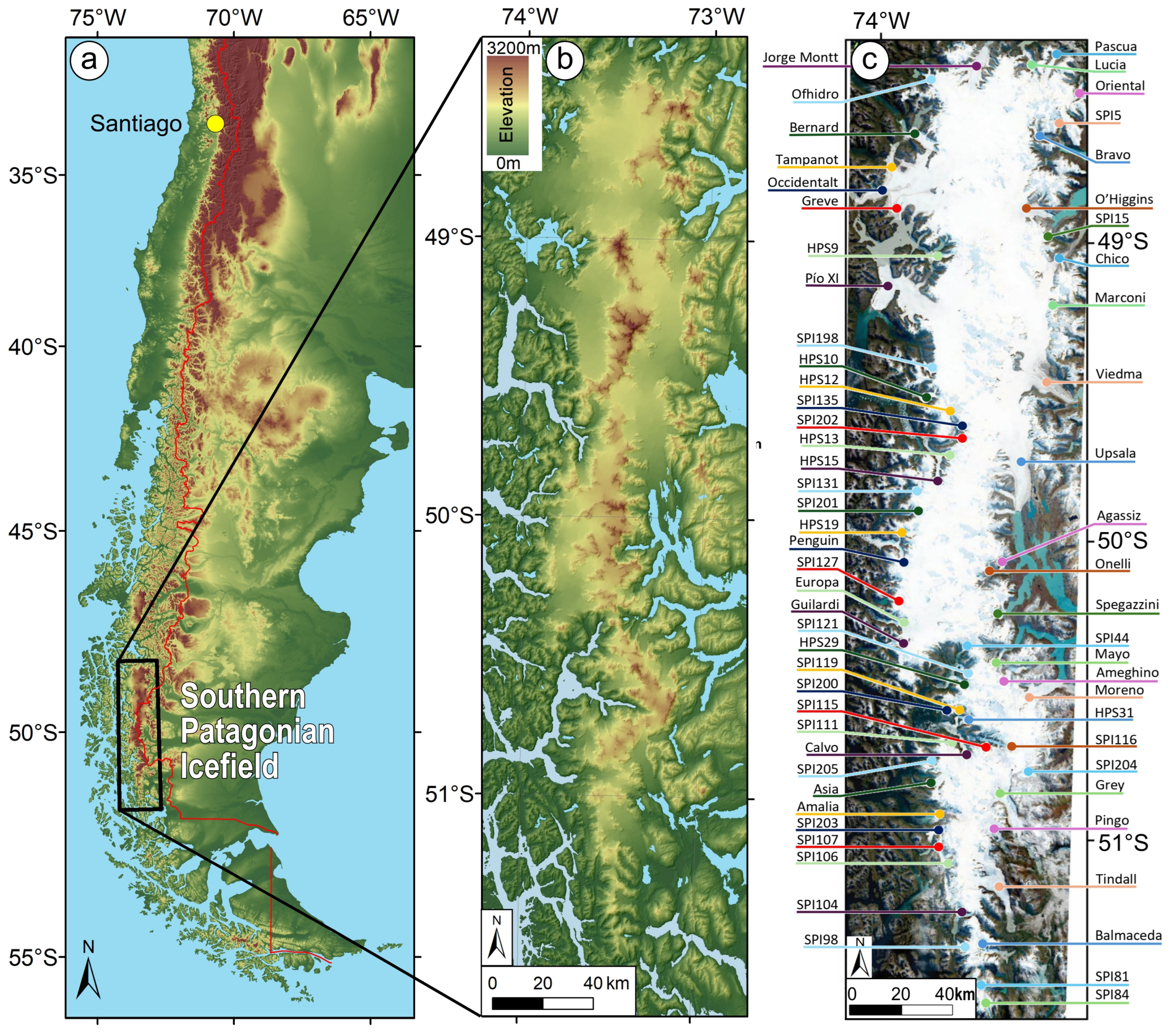
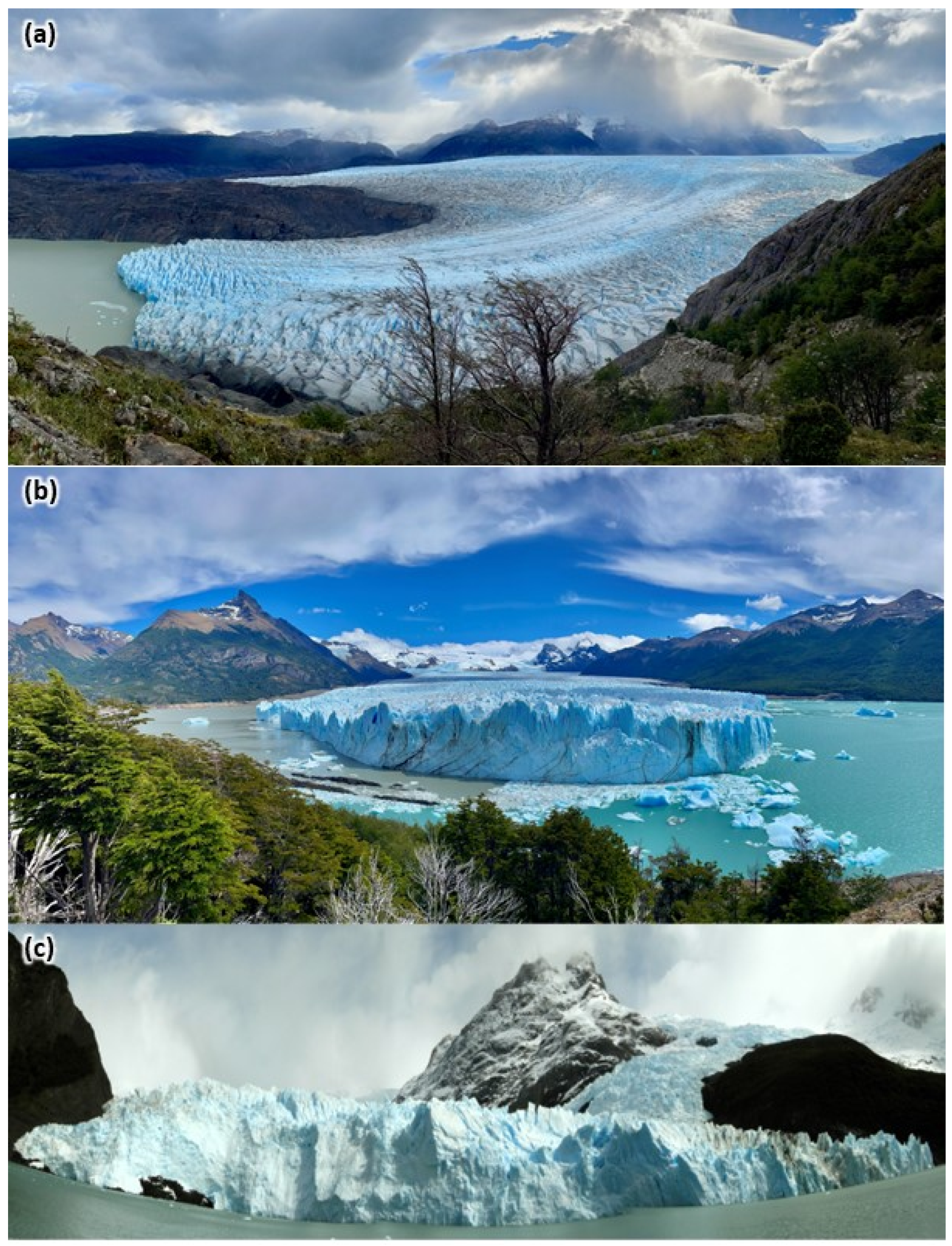
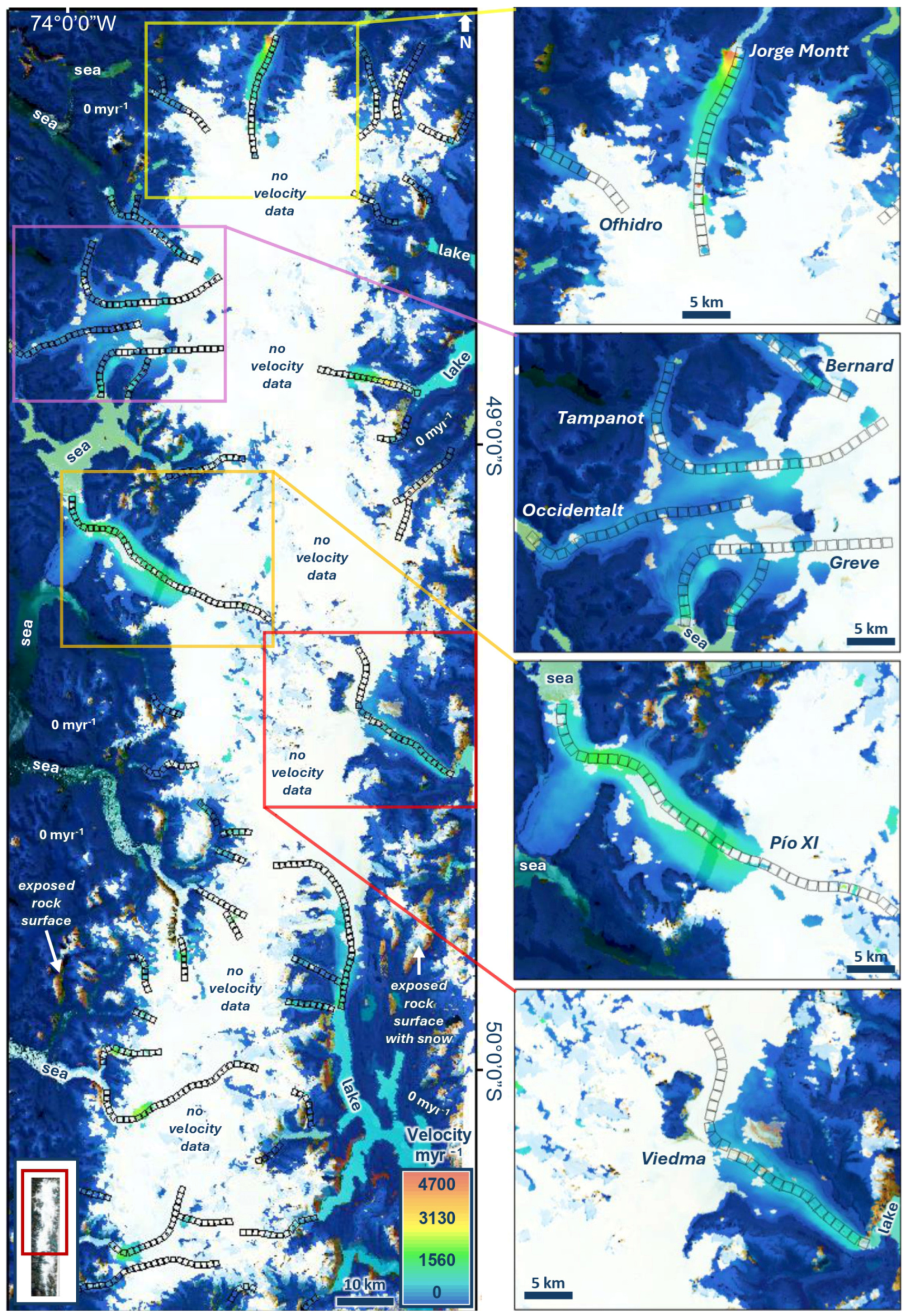
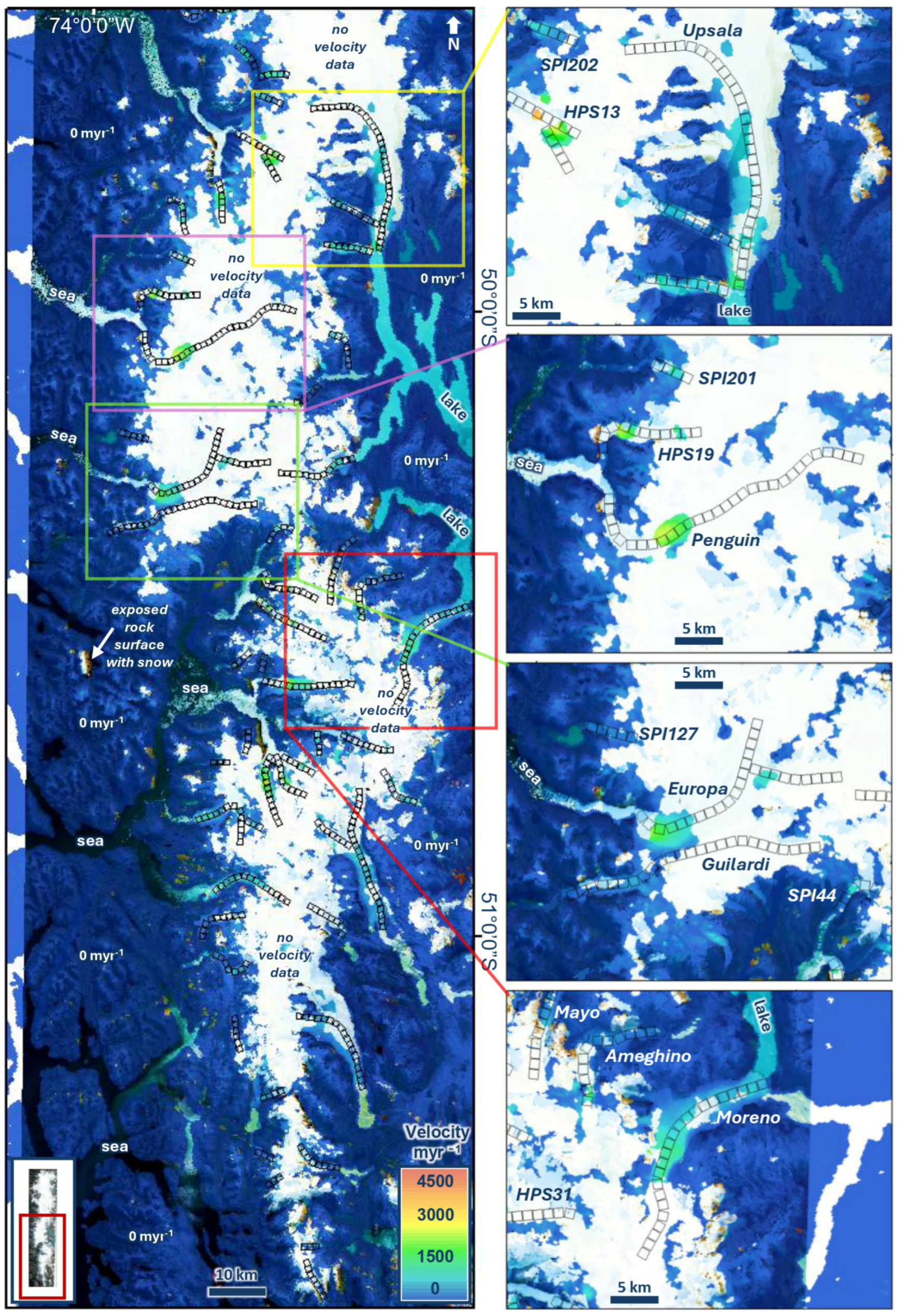
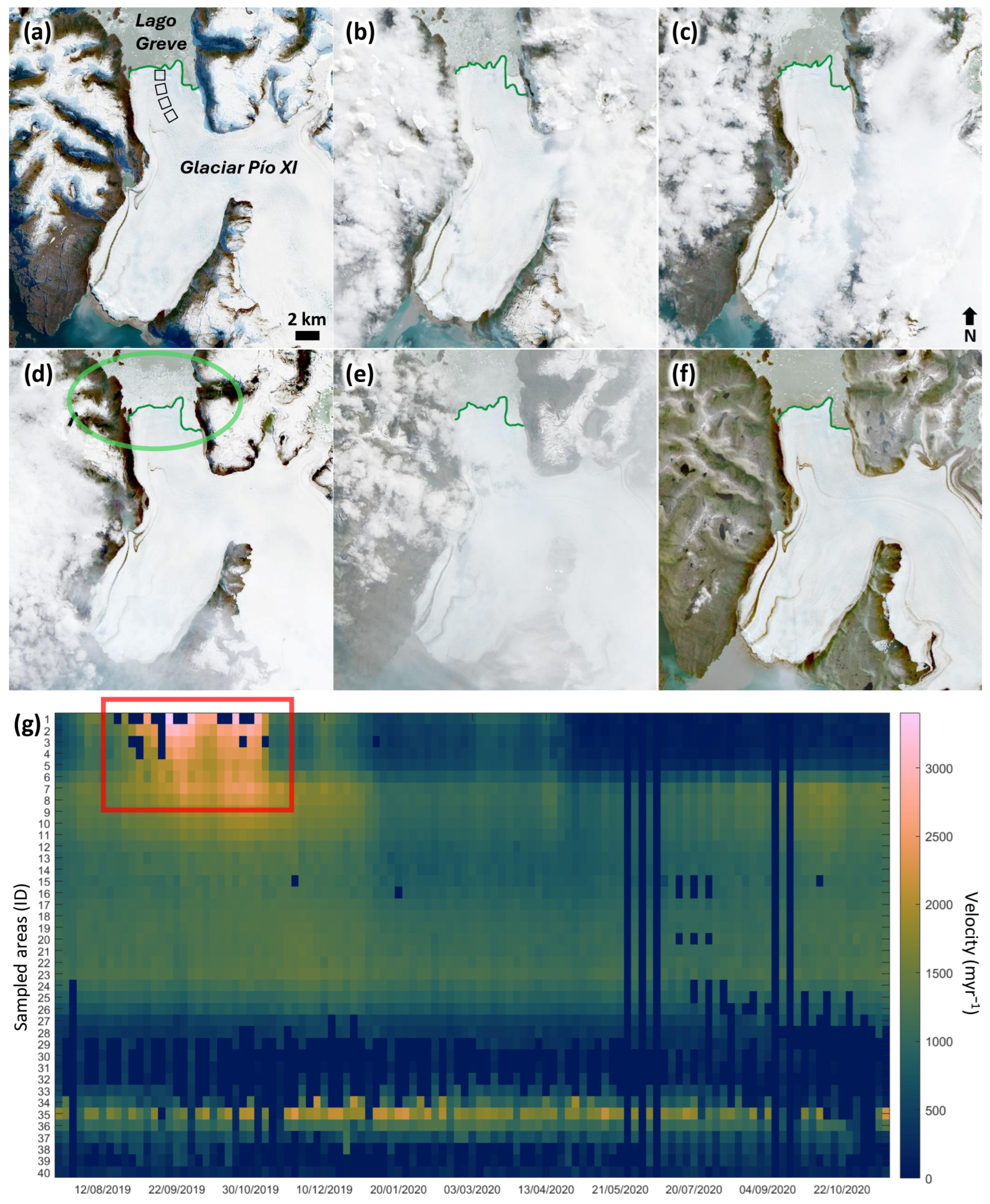
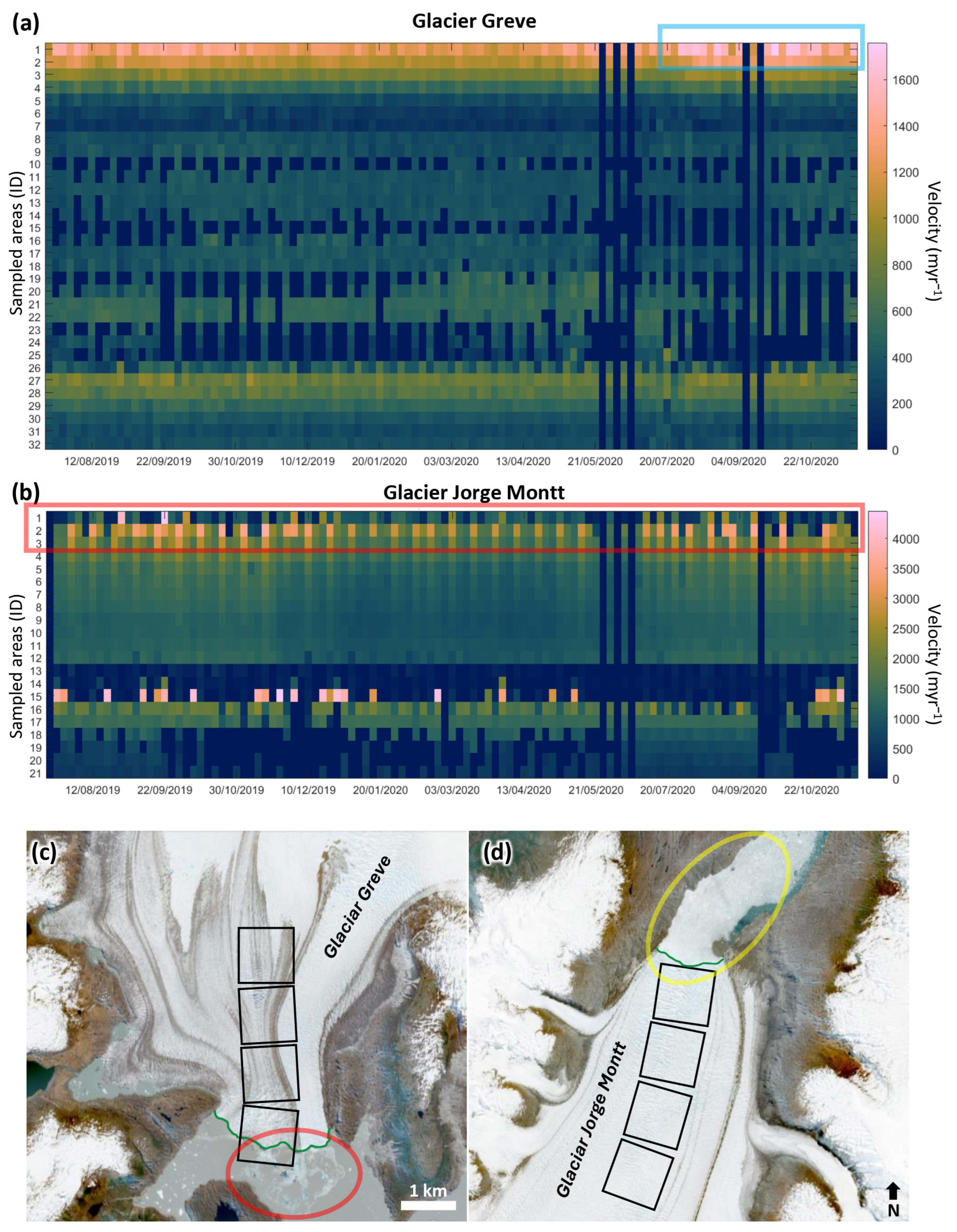
| Glacier Name or ID * | Number of Sample Areas | Glacier Area (km2) ** | Glacier Name or ID * | Number of Sample Areas | Glacier Area (km2) ** | ||
|---|---|---|---|---|---|---|---|
| 1. | Agassiz Bolados | 7 | 77.70 | 33. | Pingo | 8 | 53.31 |
| 2. | Amalia | 14 | 154.96 | 34. | Pío XI | 40 | 1244.77 |
| 3. | Ameghino | 12 | 62.27 | 35. | Snowy | 3 | 18.22 |
| 4. | Asia | 16 | 114.55 | 36. | Spegazzini | 13 | 16.33 |
| 5. | Balmaceda | 8 | 50.40 | 37. | SPI5 | 6 | 31.68 |
| 6. | Bernard | 21 | 509.73 | 38. | SPI15 | 7 | 26.55 |
| 7. | Bravo | 9 | 89.70 | 39. | SPI44 | 5 | 34.90 |
| 8. | Calvo | 27 | 149.01 | 40. | SPI81 | 3 | 10.71 |
| 9. | Chico | 20 | 305.16 | 41. | SPI84 | 7 | 18.04 |
| 10. | Europa | 27 | 409.47 | 42. | SPI98 | 3 | 12.82 |
| 11. | Greve | 32 | 434.30 | 43. | SPI104 | 4 | 54.81 |
| 12. | Grey | 31 | 232.14 | 44. | SPI106 | 6 | 49.85 |
| 13. | Guilardi | 25 | 165.58 | 45. | SPI107 | 7 | 64.51 |
| 14. | HPS9 | 13 | 48.60 | 46. | SPI111 | 4 | 17.74 |
| 15. | HPS10 | 9 | 67.61 | 47. | SPI115 | 4 | 19.03 |
| 16. | HPS12 | 5 | 34.13 | 48. | SPI116 | 9 | 6.08 |
| 17. | HPS13 | 14 | 14.07 | 49. | SPI119 | 3 | 19.31 |
| 18. | HPS15 | 7 | 103.09 | 50. | SPI121 | 10 | 53.31 |
| 19. | HPS19 | 11 | 11.94 | 51. | SPI127 | 5 | 22.79 |
| 20. | HPS29 | 13 | 81.58 | 52. | SPI131 | 7 | 53.11 |
| 21. | HPS31 | 15 | 160.01 | 53. | SPI135 | 5 | 57.89 |
| 22. | Jorge Montt | 21 | 495.57 | 54. | SPI198 | 6 | 31.50 |
| 23. | Lucia | 17 | 146.43 | 55. | SPI200 | 4 | 18.82 |
| 24. | Mayo | 12 | 39.90 | 56. | SPI201 | 4 | 40.97 |
| 25. | Moreno | 23 | 256.13 | 57. | SPI202 | 5 | 21.37 |
| 26. | Occidentalt | 22 | 203.05 | 58. | SPI203 | 9 | 47.17 |
| 27. | Ofhidro | 15 | 72.74 | 59. | SPI204 | 8 | 57.24 |
| 28. | Ohiggins | 17 | 762.32 | 60. | SPI205 | 3 | 31.69 |
| 29. | Onelli | 5 | 43.88 | 61. | Tampanot | 31 | 315.34 |
| 30. | Oriental | 11 | 46.70 | 62. | Tindall | 18 | 302.87 |
| 31. | Pascua | 13 | 72.04 | 63. | Upsala | 49 | 792.95 |
| 32. | Penguin | 30 | 460.81 | 64. | Viedma | 28 | 884.32 |
| Glacier | Minimum Velocity (myr−1) | Maximum Velocity (myr−1) | Range of Velocity (myr−1) | Terminus Ends In | Calving Effect |
|---|---|---|---|---|---|
| Agassiz Bolados | 84.96 | 436.39 | 351.43 | proglacial lake | |
| Amalia | 161.50 | 871.60 | 710.10 | tidewater | X |
| Ameghino | 139.42 | 616.54 | 477.12 | proglacial lake | |
| Asia | 237.55 | 868.69 | 631.14 | tidewater | X |
| Balmaceda | 122.72 | 248.70 | 125.98 | proglacial lake | |
| Bernard | 45.24 | 792.54 | 747.30 | tidewater | |
| Bravo | 101.98 | 313.05 | 211.08 | proglacial lake | |
| Calvo | 45.11 | 2092.98 | 2047.87 | tidewater | |
| Chico | 64.20 | 259.25 | 195.05 | tidewater | |
| Europa | 44.91 | 1642.43 | 1597.52 | tidewater | X |
| Greve | 191.09 | 1334.82 | 1143.72 | tidewater | X |
| Grey | 171.52 | 686.11 | 514.59 | proglacial lake | |
| Guilardi | 72.73 | 348.91 | 276.19 | proglacial lake | |
| HPS10 | 117.49 | 746.67 | 629.18 | proglacial lake | |
| HPS12 | 24.14 | 715.26 | 691.11 | tidewater | |
| HPS13 | 39.59 | 2793.92 | 2754.33 | tidewater | |
| HPS15 | 119.13 | 1655.92 | 1536.79 | tidewater | X |
| HPS19 | 77.32 | 1448.92 | 1371.60 | tidewater | |
| HPS29 | 152.72 | 2518.54 | 2365.82 | tidewater | X |
| HPS31 | 113.71 | 1759.89 | 1646.18 | tidewater | X |
| HPS9 | 179.47 | 780.18 | 600.71 | tidewater | |
| Jorge Montt | 202.30 | 2263.99 | 2061.70 | tidewater | X |
| Lucia | 254.51 | 673.17 | 418.66 | proglacial lake | |
| Mayo | 105.14 | 355.86 | 250.72 | proglacial lake | |
| Moreno | 190.55 | 1147.74 | 957.19 | proglacial lake | |
| Occidentalt | 120.69 | 350.56 | 229.88 | tidewater | X |
| Ofhidro | 83.43 | 474.99 | 391.56 | proglacial lake | |
| OHiggins | 44.73 | 2685.56 | 2640.84 | tidewater | X |
| Onelli | 66.47 | 182.21 | 115.74 | tidewater | X |
| Oriental | 68.46 | 756.80 | 688.34 | proglacial lake | |
| Pascua | 27.98 | 173.93 | 145.95 | proglacial lake | |
| Penguin | 52.54 | 6491.05 | 6438.51 | tidewater | |
| Pingo | 42.50 | 601.71 | 559.21 | proglacial lake | |
| Pío XI | 198.08 | 1499.23 | 1301.15 | tidewater | X |
| Snowy | 42.44 | 226.86 | 184.43 | proglacial lake | |
| Spegazzini | 199.69 | 839.27 | 639.59 | proglacial lake | |
| SPI104 | 229.62 | 545.00 | 315.39 | proglacial lake | X |
| SPI106 | 43.94 | 85.95 | 42.01 | proglacial lake | |
| SPI107 | 138.71 | 622.56 | 483.85 | proglacial lake | |
| SPI111 | 66.96 | 95.49 | 28.53 | tidewater | |
| SPI115 | 266.84 | 582.50 | 315.66 | tidewater | X |
| SPI116 | 64.22 | 687.16 | 622.94 | tidewater | |
| SPI119 | 55.09 | 83.59 | 28.50 | tidewater | |
| SPI121 | 49.84 | 1858.63 | 1808.79 | tidewater | |
| SPI127 | 119.89 | 184.72 | 64.83 | proglacial lake | |
| SPI131 | 73.20 | 827.65 | 754.45 | tidewater | |
| SPI135 | 184.51 | 833.01 | 648.50 | tidewater | |
| SPI15 | 46.72 | 766.46 | 719.75 | proglacial lake | |
| SPI198 | 89.91 | 366.02 | 276.11 | proglacial lake | |
| SPI200 | 77.01 | 124.11 | 47.10 | tidewater | |
| SPI201 | 83.95 | 738.10 | 654.14 | tidewater | X |
| SPI202 | 192.83 | 502.38 | 309.54 | tidewater | X |
| SPI203 | 49.05 | 365.04 | 315.98 | proglacial lake | |
| SPI204 | 187.40 | 707.83 | 520.43 | proglacial lake | X |
| SPI205 | 76.54 | 183.59 | 107.05 | proglacial lake | |
| SPI44 | 65.06 | 408.94 | 343.87 | tidewater | |
| SPI5 | 51.83 | 200.16 | 148.33 | proglacial lake | |
| SPI81 | 50.99 | 190.55 | 139.57 | proglacial lake | |
| SPI84 | 30.21 | 164.27 | 134.06 | proglacial lake | |
| SPI98 | 66.32 | 118.18 | 51.86 | proglacial lake | |
| Tampanot | 160.09 | 774.94 | 614.84 | tidewater | |
| Tindall | 210.12 | 404.37 | 194.25 | proglacial lake | |
| Upsala | 106.15 | 1331.90 | 1225.75 | proglacial lake | X |
| Viedma | 59.60 | 1320.95 | 1261.35 | proglacial lake | X |
| Increasing Velocity Profile | Decreasing Velocity Profile | Single-Peak Velocity Profile | Multiple-Peak Velocity Profile | ||
|---|---|---|---|---|---|
| a | b | ||||
| Glaciers > 100 km2 | 8 | 5 | 2 | 18 | 9 |
| Glaciers < 100 km2 | 0 | 0 | 2 | 6 | 14 |
| Sample Areas | Velocity (myr−1) | ||||
|---|---|---|---|---|---|
| Maximum | Minimum | Range | Mean | Max-Mean | |
| Asia_1 | 1108.83 | 438.47 | 670.36 | 868.69 | 240.14 |
| Asia_2 | 721.94 | 527.63 | 194.31 | 626.54 | 95.40 |
| Asia_3 | 895.28 | 619.68 | 275.60 | 798.02 | 97.26 |
| Europa_1 | 109.61 | 8.93 | 100.68 | 44.91 | 64.70 |
| Europa_2 | 1832.24 | 917.53 | 914.72 | 1523.17 | 309.07 |
| Europa_3 | 1797.39 | 1404.00 | 393.38 | 1642.43 | 154.96 |
| Europa_4 | 1303.18 | 1007.06 | 296.13 | 1185.63 | 117.55 |
| Greve_1 | 1759.04 | 1059.98 | 699.06 | 1334.82 | 424.22 |
| Greve_2 | 1415.06 | 980.49 | 434.58 | 1138.63 | 276.43 |
| Greve_3 | 1026.35 | 771.37 | 254.98 | 880.88 | 145.46 |
| Greve_4 | 762.29 | 477.65 | 284.65 | 585.50 | 176.80 |
| JorgeMontt_1 | 4369.47 | 139.94 | 4229.53 | 1047.71 | 3321.76 |
| JorgeMontt_2 | 3768.96 | 364.78 | 3404.18 | 2263.99 | 1504.97 |
| JorgeMontt_3 | 3176.24 | 1304.99 | 1871.26 | 1963.99 | 1212.26 |
| JorgeMontt_4 | 2512.15 | 1216.09 | 1296.06 | 1743.35 | 768.79 |
| OHiggins_4 | 3153.73 | 73.14 | 3080.58 | 951.25 | 2202.48 |
| OHiggins_5 | 3007.50 | 1142.22 | 1865.27 | 2685.56 | 321.93 |
| OHiggins_6 | 2959.15 | 1372.70 | 1586.45 | 2659.32 | 299.83 |
| OHiggins_7 | 2584.55 | 2027.06 | 557.49 | 2214.23 | 370.32 |
| Upsala_1 | 1674.50 | 783.31 | 891.19 | 1331.90 | 342.60 |
| Upsala_2 | 1473.38 | 951.50 | 521.87 | 1161.13 | 312.25 |
| Upsala_3 | 1170.05 | 561.94 | 608.11 | 922.38 | 247.67 |
| Viedma_1 | 1819.16 | 1007.03 | 812.12 | 1320.95 | 498.20 |
| Viedma_2 | 1114.44 | 878.96 | 235.48 | 1003.64 | 110.81 |
Disclaimer/Publisher’s Note: The statements, opinions and data contained in all publications are solely those of the individual author(s) and contributor(s) and not of MDPI and/or the editor(s). MDPI and/or the editor(s) disclaim responsibility for any injury to people or property resulting from any ideas, methods, instructions or products referred to in the content. |
© 2025 by the authors. Licensee MDPI, Basel, Switzerland. This article is an open access article distributed under the terms and conditions of the Creative Commons Attribution (CC BY) license (https://creativecommons.org/licenses/by/4.0/).
Share and Cite
Jó, V.; Telbisz, T.; Ignéczi, Á.; Van Wyk De Vries, M.; Ruiz-Pereira, S.; Mari, L.; Nagy, B. Surface Velocity and Dynamics of the Southern Patagonian Icefield Using Feature and Speckle Tracking Methods on Sentinel-1 SAR Images During 2019–2020. Remote Sens. 2025, 17, 3742. https://doi.org/10.3390/rs17223742
Jó V, Telbisz T, Ignéczi Á, Van Wyk De Vries M, Ruiz-Pereira S, Mari L, Nagy B. Surface Velocity and Dynamics of the Southern Patagonian Icefield Using Feature and Speckle Tracking Methods on Sentinel-1 SAR Images During 2019–2020. Remote Sensing. 2025; 17(22):3742. https://doi.org/10.3390/rs17223742
Chicago/Turabian StyleJó, Viviána, Tamás Telbisz, Ádám Ignéczi, Maximillian Van Wyk De Vries, Sebastián Ruiz-Pereira, László Mari, and Balázs Nagy. 2025. "Surface Velocity and Dynamics of the Southern Patagonian Icefield Using Feature and Speckle Tracking Methods on Sentinel-1 SAR Images During 2019–2020" Remote Sensing 17, no. 22: 3742. https://doi.org/10.3390/rs17223742
APA StyleJó, V., Telbisz, T., Ignéczi, Á., Van Wyk De Vries, M., Ruiz-Pereira, S., Mari, L., & Nagy, B. (2025). Surface Velocity and Dynamics of the Southern Patagonian Icefield Using Feature and Speckle Tracking Methods on Sentinel-1 SAR Images During 2019–2020. Remote Sensing, 17(22), 3742. https://doi.org/10.3390/rs17223742







